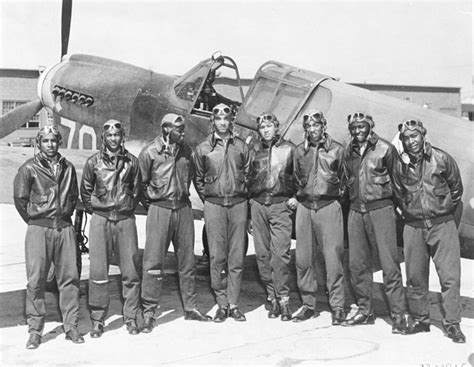The Tuskegee Airmen, a group of predominantly African American military pilots and support staff, played a pivotal role in the history of World War II. Active from 1941 to 1946, they were the first African American military aviators in the United States Armed Forces. The Tuskegee Airmen flew their first combat mission on June 2, 1943, and went on to distinguish themselves as one of the most respected and successful units of the war.
The origins of the Tuskegee Airmen date back to the early 1940s, when the U.S. Army Air Corps (USAAC) began to consider training African American pilots. At the time, the military was still segregated, and African American soldiers were not allowed to serve in combat roles. However, with the onset of World War II, the need for pilots became increasingly urgent, and the USAAC began to explore the possibility of training African American aviators.
In 1941, the U.S. Army Air Corps established the 99th Pursuit Squadron, later known as the 99th Fighter Squadron, at the Tuskegee Army Air Field in Alabama. The squadron was composed of African American pilots, mechanics, and support staff, and was trained by white instructors. The first class of African American pilots, known as the “Class of 42-C,” began training in July 1941 and included notable figures such as Captain Benjamin O. Davis Jr., who would later become the first African American general in the U.S. Air Force.
Despite facing numerous challenges, including racism and skepticism from some of their white counterparts, the Tuskegee Airmen persevered and demonstrated exceptional skills and dedication. They flew a variety of aircraft, including the P-40 Warhawk, P-47 Thunderbolt, and P-51 Mustang, and compiled an impressive combat record.
The Tuskegee Airmen’s most notable achievements include:
- Flying over 15,000 sorties
- Destroying over 260 enemy aircraft
- Sinking one enemy destroyer
- Winning numerous awards and decorations, including the Distinguished Unit Citation, the Presidential Unit Citation, and the Congressional Gold Medal
Their sacrifices and achievements paved the way for future generations of African American military personnel and contributed significantly to the eventual desegregation of the U.S. Armed Forces.
The Tuskegee Airmen’s legacy extends far beyond their military accomplishments. They served as role models and inspirations for African American communities across the United States, demonstrating that with hard work, determination, and perseverance, anything is possible.
The Tuskegee Airmen’s story has been the subject of numerous books, films, and documentaries, including the 2012 movie “Red Tails,” which highlights their heroic exploits during World War II. Their legacy continues to inspire new generations of Americans, reminding us of the importance of courage, sacrifice, and the pursuit of equality and justice.
To Learn More About Tuskegee Airmen History and records you may want to explore official historic sites.



